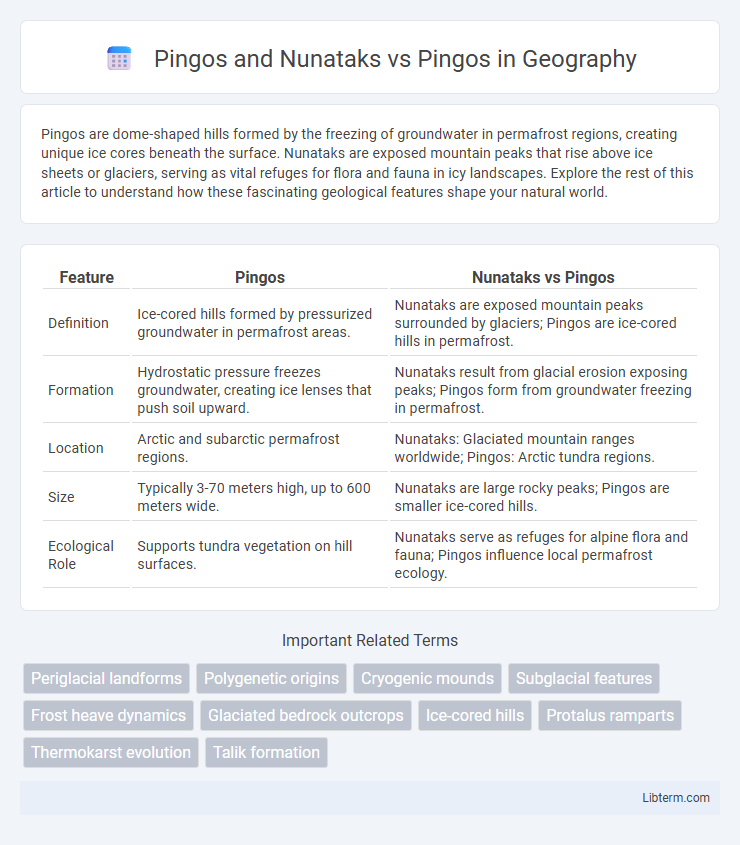Pingos are dome-shaped hills formed by the freezing of groundwater in permafrost regions, creating unique ice cores beneath the surface. Nunataks are exposed mountain peaks that rise above ice sheets or glaciers, serving as vital refuges for flora and fauna in icy landscapes. Explore the rest of this article to understand how these fascinating geological features shape your natural world.
Table of Comparison
| Feature | Pingos | Nunataks vs Pingos |
|---|---|---|
| Definition | Ice-cored hills formed by pressurized groundwater in permafrost areas. | Nunataks are exposed mountain peaks surrounded by glaciers; Pingos are ice-cored hills in permafrost. |
| Formation | Hydrostatic pressure freezes groundwater, creating ice lenses that push soil upward. | Nunataks result from glacial erosion exposing peaks; Pingos form from groundwater freezing in permafrost. |
| Location | Arctic and subarctic permafrost regions. | Nunataks: Glaciated mountain ranges worldwide; Pingos: Arctic tundra regions. |
| Size | Typically 3-70 meters high, up to 600 meters wide. | Nunataks are large rocky peaks; Pingos are smaller ice-cored hills. |
| Ecological Role | Supports tundra vegetation on hill surfaces. | Nunataks serve as refuges for alpine flora and fauna; Pingos influence local permafrost ecology. |
Understanding Pingos: Definition and Formation
Pingos are dome-shaped ice-cored hills formed in permafrost areas when groundwater freezes and expands, pushing the soil upward. Nunataks differ as exposed mountain peaks protruding above glaciers or ice sheets, representing rocky outcrops rather than ice-related mounds. Understanding pingos involves recognizing the hydrostatic pressure and congelation processes that create these unique periglacial landforms.
What Are Nunataks: Distinctive Features
Nunataks are exposed, often rocky peaks that protrude above surrounding ice fields or glaciers, serving as isolated habitats amidst vast ice expanses. Unlike pingos, which are ice-cored mounds formed by groundwater pressure in permafrost regions, nunataks exhibit rugged terrain shaped by erosion and lack significant ice cores. Their distinctive features include steep, weathered rock surfaces and ecological refuges for specialized plant and animal species in glaciated landscapes.
Pingos vs Nunataks: Key Differences
Pingos are dome-shaped, ice-cored hills formed by the freezing of groundwater in permafrost regions, while nunataks are exposed mountain peaks protruding above ice sheets or glaciers. Pingos develop through hydrostatic pressure pushing up soil and ice, typically found in Arctic tundra environments, whereas nunataks are geological features representing bedrock unaffected by glacial coverage. The key difference lies in their origin: pingos result from cryogenic ice accumulation beneath sediments, and nunataks are remnants of pre-existing topography emerging through glacial ice.
Geological Processes Behind Pingos
Pingos form through the uplift of soil and sediment caused by the freezing of pressurized groundwater in permafrost regions, creating dome-shaped ice-cored hills; this hydrostatic pressure drives the upward displacement. Nunataks, contrastingly, are exposed mountain peaks protruding above glaciers or ice sheets, resulting from glacial erosion and ice thinning rather than internal ground ice dynamics. Understanding the hydrogeological and cryogenic processes behind pingos clarifies their distinction from nunataks, which are shaped primarily by surface glacial activity.
Ecosystem Impact: Pingos and Nunataks
Pingos create unique wetland ecosystems by trapping water atop permafrost mounds, supporting specialized flora and fauna adapted to cold, moist environments. Nunataks, exposed rocky peaks amid glaciers, serve as critical refuges for resilient alpine species, promoting biodiversity in otherwise ice-covered regions. Both landforms strongly influence local microclimates and habitat diversity, playing essential roles in Arctic and subarctic ecological networks.
Pingos in the Arctic Landscape
Pingos are distinct dome-shaped ice-cored hills predominantly found in Arctic permafrost regions, formed by the pressure of groundwater freezing and expanding beneath the surface. Nunataks, in contrast, are exposed mountain peaks surrounded by glaciers, acting as isolated habitats rather than ice mounds. The presence of pingos in the Arctic landscape provides critical indicators of permafrost dynamics and groundwater movement, crucial for understanding climate change impacts on frozen ground stability.
Nunataks: Islands in a Sea of Ice
Nunataks, unlike pingos, are exposed mountain peaks that protrude above glaciers or ice sheets, acting as islands in a sea of ice. These rocky outcrops provide unique ecological niches for hardy vegetation and serve as critical refuges for wildlife during glacial periods. Nunataks offer valuable geological insights into ice sheet dynamics and climate change through preserved rock formations and fossil records.
Climatic Significance of Pingos and Nunataks
Pingos and nunataks serve as vital indicators of past and present climatic conditions, with pingos reflecting permafrost dynamics due to their ice-cored mounds formed in cold regions, signaling active freeze-thaw cycles. Nunataks, exposed peaks protruding above glaciers, provide critical insights into glacial history and climatic fluctuations by preserving ancient rock formations and ecosystems isolated from surrounding ice fields. Both features contribute to understanding climate change impacts, where pingos reveal ground temperature variations, and nunataks offer benchmarks for glacial retreat and biodiversity resilience.
Erosion and Longevity: Pingos vs Nunataks
Nunataks, exposed rocky peaks protruding through ice sheets, resist erosion due to their solid bedrock composition, often persisting for thousands of years as stable glacial refugia. In contrast, pingos are ice-cored hills formed in permafrost regions, highly susceptible to erosion once the ice core melts, leading to rapid degradation and shorter lifespans. The contrasting erosion rates directly influence the longevity of these landforms, with nunataks offering long-term geological stability, while pingos remain transient features sensitive to climatic changes.
Research Importance: Studying Pingos and Nunataks
Studying pingos and nunataks provides critical insights into permafrost dynamics and glacial history, with pingos serving as indicators of subsurface ice processes and verdant nunataks revealing past ice sheet extents. Research on pingos enhances understanding of cryogenic landform development and climate change impacts in Arctic regions, while nunataks contribute valuable data on biological refugia and species adaptation during glacial cycles. Comparative analysis of these features advances knowledge of Earth's cryosphere stability and informs predictive models for future environmental shifts.
Pingos and Nunataks Infographic

 libterm.com
libterm.com